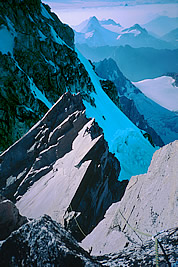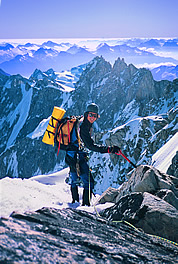 |
 discovered the joy of ridge enchainments in the summer of 2003 with the Southern Pickets. After a few conversations with Don Serl that fall on Waddington, I was fixated on trying its Traverse. Mark Bunker, my only climbing partner as weird and eccentric as I am (With whom else can I discuss the ideal shape of the small plastic knob on the pot lid?), was psyched as well. After some great advice from Don and some persuading of Mark’s boss, we hit the road from Seattle and found ourselves at the hamlet of Bluff Lake, which was rapidly turning into a fire camp. discovered the joy of ridge enchainments in the summer of 2003 with the Southern Pickets. After a few conversations with Don Serl that fall on Waddington, I was fixated on trying its Traverse. Mark Bunker, my only climbing partner as weird and eccentric as I am (With whom else can I discuss the ideal shape of the small plastic knob on the pot lid?), was psyched as well. After some great advice from Don and some persuading of Mark’s boss, we hit the road from Seattle and found ourselves at the hamlet of Bluff Lake, which was rapidly turning into a fire camp.
 |
 |
|
Colin Haley on Serra II. Enlarge. © Mark Bunker. |
|
 |
On July 26, Whitesaddle Air Services flew us up to the Plummer Hut, where we quickly dumped out our basecamp cache. We were then whisked over to Fury Gap with The Doors’ “The End”eerily playing in the helicopter headphones. After a couple of experiences getting dropped off in Alaskan basecamps with ridiculous quantities of gear, being left in the middle of nowhere with only two small backpacks felt liberating. We spent the day rambling up Waddington’s scenic West Ridge under bluebird skies, and pitched a camp that afternoon at the base of the Angel Glacier.
We spent the 27th lounging in camp to acclimatize, and then headed up the Angel Glacier with daypacks early on the 28th. From the upper Angel Glacier, we dropped toward the base of the summit tower and here we encountered our first evidence of dry conditions – the snow gully we expected was instead hard ice and required time-consuming tool-swinging all the way down. We climbed the lower portion of the summit tower via the Wadd-hose, and the upper portion via the rock to the right of the chimney, with a few tense moments as ice mushrooms fell and crashed in the sun. It felt great to to be on top of a mountain I’d read about for so long, and the dry conditions had exposed a really old summit register through which we briefly leafed. Right before leaving the summit, I saw Jeff and Brent (from CA and CO) nearing the top by the NW Ridge of the summit tower. Before descending the Angel Glacier back to camp, we couldn’t resist quickly romping up the NW summit for the unforgettable view of the main summit.
On the morning of the 29th we headed down towards Combatant Col. Instead of the easy glacial stroll I’ve seen in old photos, we found a jumbled mess and even made one rappel from an ice horn. The NW slope of Combatant was much icier than we expected but moderate and enjoyable ridge-climbing led to Combatant’s summit. The descent from the Great Couloir Notch to Chaos Col was slow and tiring; once again the “snow slope” turned out to be an ice slope.
On Tiedemann’s west face, we mostly stayed on the excellent-quality rock because all the front pointing had rendered the balls of our feet quite sore. When we arrived at the summit, exhaustion persuaded us to camp right there even though daylight remained. Perched 1600 meters above the Tiedemann Glacier, we felt vulnerable when the wind picked up and shook our tent that night but we woke to find it calm and clear once again.
 |
 |
|
Colin Haley descending Tiedemann. Enlarge. © Mark Bunker |
|
 |
We started up Asperity’s west ridge well into the afternoon of the 30th, already tired. We spent seven hours descending Tiedemann, encountering one 20 meter section of the worst rock I have ever climbed and, you guessed it, a hard ice face instead of the expected snow slope. Our spirits were soon lifted however by the delightful climbing on Asperity. Mark and I both agreed that the Northwest ridge, with its perfect snow arête and flawless rock, must be one of the most classic routes in the range – Fred Beckey sure seems to know how to pick ’em. Two rappels off of rock anchors, some steep downclimbing, and finally the painstaking bollards brought us staggering under a full moon into the Asperity-Serra col, where we were delighted to find a tent platform already stomped out (a pair of climbers had climbed Serra 5 a couple days before, accessed from the Tiedemann Glacier).
On the chilly morning of the 31st we climbed the NW corner of Serra 5, which was composed of excellent rock mixed with ice patches. Lacking a pencil, Mark signed our initials in the summit register using his blood, as Guy Davis and Carl Diedrich had in 1989 after the first ascent of Thunderbird. We took our time lounging on the summit, not particularly eager to start the descent down the east face, which Don had warned was the crux of the traverse. While setting up the first rappel and with just a nudge, I launched a refrigerator-sized block off the mountain, not helping our nerves. We made a total of 3 and a half 50 meter rappels, always struggling to untangle the 6mm rap line, and arrived at the 4-5 col very late in the day. We immediately started up Serra 4, which went quickly and easily, and arrived just after dark at a bivy ledge between Serras 3 and 4 - the only camp during the traverse where we couldn’t pitch a tent. We still had plenty of fuel, but my dinner that night consisted of rice flavored with Cytomax.
On the fifth and last day of our traverse, Mark crested over a false summit of Serra 3 and yelled down with a deranged and excited look on his face, “Humans!” We quickly tagged Serra 3, and caught up with the super-nice Peter and Katy part way up Serra 2 as they were descending (Katy Holm’s article about Waddington appears in last year’s Canadian Alpine Journal). We rappelled down to the Tellot Glacier late in the evening and started up The Ladies Route on Serra 1 at 9pm. After so much frontpointing along the traverse, two pitches of alpine ice was the last thing we were hoping for. We tied our two ropes together and I led up a 100 meter pitch with the best of our four “ice tools.” Mark followed quickly with the even less-adequate tools and crampons that were, at this point, held on by string. It was around midnight, seven days after starting, that we summitted Serra 1, completing what we believe to be the second traverse of the Waddington Group.
We stumbled down the Tellot Glacier by moonlight and dove into our cache below the Plummer hut. The next morning, we set to the demanding tasks of eating huge quantities of food and drinking Kokanee; we marveled at our extreme luck with the weather when sleet and snow began falling that night.
We spent another week hanging out around the Plummer Hut, eating tons of food, raiding the first aid kit for recreational painkillers, generally acting insane, and wandering around the Tellot Glacier in storms to bag some smaller summits (Claws 1-4, Shand, McCormick, Termination, Eaglehead, and Dragonback).
I was very impressed with the Waddington Range throughout the trip; I think it is remarkably similar to the Mont Blanc massif without the trams, towns, and crowds. I highly recommend The Traverse to those traveling to Waddington. Never extreme, it is consistently technical and always spectacular.
|
 |
| Summary |
The first ascent of the traverse was completed over five days in July, 1985, by Peter Croft, Greg Foweraker, and Don Serl. In his guidebook to the Waddington Range, The Waddington Guide (Elaho Publishing, 2003) Don Serl wrote:
“The Waddington Range Traverse” is one of the great alpine outings in America. It travels the highest crest, the very backbone, of the Range, covering about 18 km of climbing terrain and including about 4,000m of ascent while overcoming 11 summits between 3,500m and 4,000m. Surprisingly, the technical difficulties are not very high, but the commitment is huge—the central portions of the route lie on exceptionally isolated ridges 1,500m and more above the surrounding glaciers, and escape in bad weather would be serious.”
As did Colin and Mark, whose climb is recounted here, the 1985 party found some of the greatest challenge in descending some of the peaks.
|
 |
| Party |
 |
• Colin Haley
• Mark Bunker |
 |
| Itinerary |
 |
July 26
•
Fly in basecamp cache
• Establish camp on Angel Glacier
July 27
•
Acclimatize
July 28
• Climb West Ridge of Waddington & return to Angel Glacier camp.
July 29
• Ascend Combatant
• Descend to Chaos Col
• Ascend West Face of Tiedemann
• Bivi on summit of Tiedemann
July 30
•
Descend Teidemann (7 hours)
• Ascend Northwest Ridge of Asperity
• Descend to Asperity-Serra Col
July 31
• Ascend Northwest Corner of Serra 5
• Descend East Face to the Serra 4-5 col
• Ascend Serra 4
• Bivi on Serra 3-4 Ridge
August 1
• Ascend Serra 3
• Ascend Serra 2
• Descend to Tellot Glacier
• Ascend Ladies Route on Serra 1
• Descend to Plummer Hut cache |
 |
| Summits |
 |
• Waddington
• Combatant
• Tiedemann
• Asperity
• Serra 5
• Serra 4
• Serra 3
• Serra 2
• Serra 1 |
| |
|
 |



